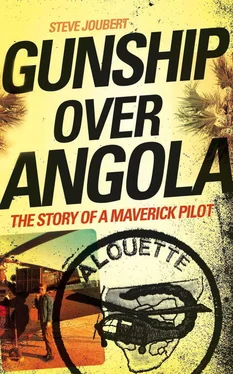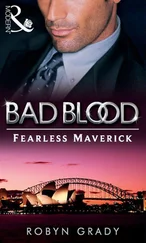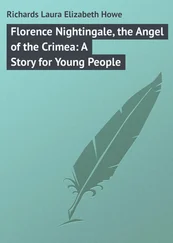I remembered this sound counsel, and offered it to other newbies throughout my gunship career.
The raid was launched at around 11h00 with the Buffel-mounted infantrymen rushing across the cutline from two crossing points situated about 1 500 metres apart. Once in the vicinity of the PLAN gathering, their brief was to debus rapidly, spread out and encircle the PLAN fighters and cut off the escape route of the enemy soldiers caught in the pincer movement.
The role of the Noddy cars was to drive right into the middle of the conflict and cause havoc.
As gunships, our job was to provide air support to the troops on the ground and to give an overall view of the unfolding fight to the battle commander sitting on the ammunition box in Chris’s chopper.
As the Noddy cars approached the border, I remembered that one of the instructions issued to vehicle commanders at the earlier briefing was for all combat vehicles to avoid driving on the road crossing the border at any cost. So, when I noticed a Noddy car driving up the tarred road through the no-man’s land between the two opposing border posts, being a rookie and without a shred of battlefield experience, I contemplated calling out a warning on the radio to the vehicle crew, but didn’t, for fear that I might make a fool of myself.
Seconds later, the Noddy car reached the boom across the road at the Angolan border post and detonated the multiple landmines buried beneath it. The Noddy car flew straight up into the air, borne aloft by a boiling, roiling cloud of black and orange smoke and flame, slowly twisting around like it wanted to look at the gaping hole that had suddenly appeared on the spot where it had just been. It seemed to hesitate for a few seconds at the apex before it crashed down onto its roof in a shower of sparks, instantly killing two of its three occupants.
In a countryside as flat as Ovamboland, the tell-tale signature of a landmine detonation, a dark-grey spearhead rising vertically above the incident site, is visible from up to 70 kilometres away and can be seen within seconds of the detonation occurring. It is my most unfortunate reality to have observed a number of these abominations and to have arrived on the scene within minutes of the blast. In my opinion, the burying of landmines and improvised explosive devices (IEDs) on public roads is one of the most depraved and immoral features of warfare.
My second encounter with the landmine scourge happened just a few weeks into my first operational tour and occurred on Oom Willie se pad between Eenhana and Oshikango. A vehicle laden with local Ovambo residents – men, women and children returning from a shopping trip to a nearby market – had detonated a landmine. There were no survivors, and no amount of effort by the medical rescue teams could determine the number of casualties, their genders or their ages. It was not even possible to identify the make of vehicle, although we were later informed it was a Toyota light delivery vehicle. Wreckage from the vehicle, body parts and the tattered remains of the occupants’ purchases were strewn over a radius of 300 metres from the blast site.
The impression still retained in my memory bank today, nearly 40 years later, is of a distorted and indescribably violent nightmare scene where everything – trees, bushes, metal and flesh – had been shredded, as if a giant food processor had brought its spinning blades to bear on this small patch of African soil.
The scale of destruction that I witnessed that day shattered forever any illusions I may have had about the morality of conflict between people, no matter how complicated the issues involved might be. Surely we humans are better than this?
But the switch in my brain was thrown and I carried on with my work.
*
Just a week or two later, flying at treetop level towards Ruacana from Ondangwa over the open grasslands between Ovamboland and the starkly beautiful Kaokoland, I saw the tell-tale signature of the landmine beast again, about 20 kilometres away and just to the left of the Alo’s nose. I reported the explosion to the nearest base by radio and then headed straight for the scene, arriving at the blast site just minutes later.
I came across a Buffel that had detonated a mine. Well, actually, the Buffel had simultaneously detonated three Soviet TM-57 mines, which are shaped like rounds of Gouda cheese, and which had been placed one on top of the other, just in case ten kilograms of high explosive wasn’t enough. It was like using a 12-gauge shotgun to swat flies. The occupants of the vehicle, those who were still alive, were writhing grotesquely in the sand in a disorderly ring around the burning wreck.
As I circled around them at a height of a few hundred feet, it seemed to me that they must have been travelling bare-chested at the moment that the mines had exploded, because none of them had on the nutria-brown shirts normally worn by our soldiers. Closer inspection showed that some of them were trouserless too.
The radio crackled into life and someone from the operations room at the nearby base asked whether the injured troops below me were white or black. This really got my back up, as I felt that the skin colour of the troops was immaterial.
‘They’re our guys!’ I shouted into the radio. ‘Just get medical help here, asap!’
‘Are they black guys or white guys?’ the voice persisted.
‘They are all white, but what the fuck does that matter?’ I spat back.
‘We have already dispatched medical people to your location and the casevac choppers are on their way too but we have no white troops in the area,’ he responded. ‘Are you sure the guys you are looking at are white?’
I was about to erupt with anger and indignation at what I saw as senseless racism but decided first to get a closer view of the casualties. I descended to around 100 feet (30 metres) above the ground, circling the smouldering wreck of the Buffel.
Flip Pretorius and I saw the shocking reality at the same instant.
‘They’re black guys, Loot,’ he said quietly, ‘but their skins are burnt off.’
Once again, my automatic switch activated again and numbed my brain.
On Christmas morning 1979 at around 06h00, while all of us Alo crews were dozing in our beds at AFB Ondangwa, contemplating a rare rest day and a substantial feast for lunch, there was a single loud explosion from a distance of about one kilometre away. Since I wasn’t that familiar yet with the full range of Border War sounds, my first instinct was to think it was a mortar being fired at us. I braced for the imminent impact and started to plan my escape route to the underground shelter, located a few metres away from the door of our terrapin. But there was no sound of a mortar exploding and I relaxed again.
At breakfast, we were told that a civilian vehicle containing three local Home Guard soldiers, who were travelling to their homes in Oshakati along the main road from Ondangwa, had detonated three Soviet TM-57 cheese mines laid by PLAN in the tarmac. The explosion, which killed all three men, had occurred just a few hundred metres past the entrance to AFB Ondangwa. It served as a chilling reminder to all of us of the proximity of the conflict to our ‘home’.
Consequently, we politely declined any invitations to drive on the roads in the area, even if just to visit the shops in nearby Ondangwa town, citing the oft-repeated excuse that if God had meant for SAAF aircrew to drive or walk on the ground, the colour of the earth would have been blue and not brown.
That Christmas morning also delivered a surprise of infinite personal value to me – a parcel of goodies from my parents. On its own, this was not a rare thing, but the parcel contained a card, handwritten by my mother, which remains one of my most treasured mementos. It was also the last written communication that I would ever get from her. It reads:
Читать дальше












